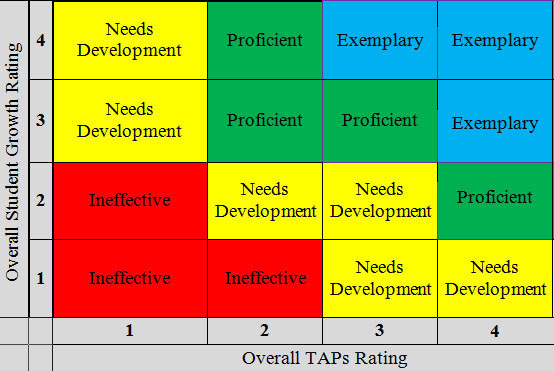
During the week of July 20, 2015, the DeKalb County School District distributed merit pay from a federal program, Race to the Top, to 1,830 teachers, who were identified as the top 20 percent of teachers in 2014-2015 school year using the newly calculated Teacher Effectiveness Measure (TEM) from the Georgia Department of Education (GDOE).
Tier 1 – $2,500 was awarded to the top 10 percent of teachers
Tier 2 – $869.75 was awarded to the next 10 percent of teachers.
Note: The merit pay awards were distributed according to the district’s approved merit pay plan. However, the merit pay awards may have exceeded the top 20% since many teachers had the same TEM score and could not be ex-cluded if that TEM score in the top 20% qualified for merit pay. There were numerous teachers with the same TEM score which resulted in the district awarding beyond 20% of the teachers in the district (Approximately 29%).
Teachers eligible for merit pay were identified as active employees at the time of the merit pay distribution, were employed by DCSD in SY2013-2014 and SY2014-2015, had student growth data in SY2013-2014 or earned a Level IV or Exemplary on Teacher Assessment of Performance Standards (TAPS) for SY2014-2015 if they had no student growth data in SY2013-2014.
TEM Score
The TEM score consists of a TAPS score and the Student Growth Score as calculated by the GDOE.
TAPS Score
Teachers earned the TAPS score which is the SY2014-2015 annual evaluation by the teacher’s principal outcome they received in April or May. A TAPS rating of 1-4 is earned as follows:
Level 1 – TAPS score of 0-6
Level 2 – TAPS score of 7-16
Level 3 – TAPS score of 17-26
Level 4 – TAPS score of 27-30
Student Growth Score
The Student Growth Rating was calculated by the GDOE using student data from the SY2013-2014. The student growth score assigns a teacher a score of 1-4 depending on the outcome of their student data analysis as follows:
| Level 1 | • Less than 50% of students demonstrated expected or high growth (SLO Data) • Mean Growth Percentile is less Than 30 (Student Achievement Data) |
| Level 2 | • 50% or more of students demonstrated expected or high growth (SLO Data) • Mean Growth Percentile is greater than or equal to 30 and less than or equal to 40 (Student Achievement Data) |
| Level 3 | • 80% or more of students demonstrated expected or high growth (SLO Data) • Mean Growth Percentile is greater than 40 and less than or equal to 65 (Student Achievement Data) |
| Level 4 | • 90% of more of students demonstrated expected or high growth AND 50% or more of students demonstrated high growth (SLO Data) • Mean Growth Percentile is greater than 65 (Student Achievement Data) |
TEM Outcome
Using the TAPS Score and Student Growth Score, the teachers qualifying for merit pay awards were the top 20% who had TEM outcomes as follows:
Exemplary – TAPS rating of 4 and a Growth Rating of 4
Exemplary – TAPS rating of 4 and a Growth Rating of 3
Exemplary – TAPS rating of 3 and a Growth Rating of 4
Proficient – TAPS rating of 3 and a Growth Rating of 3
TEM Decision Table









 “Extremism in defense of liberty is no vice. Moderation in pursuit of justice is no virtue.”
“Extremism in defense of liberty is no vice. Moderation in pursuit of justice is no virtue.”
Stan, what about the many hardworking Special Education teachers? There is no way to evaluate them by performance. If you have ever visited their class you will see them changing diapers, wiping the ever running noses of many small ones, or trying to calm a child in a meltdown (often they are black and blue from kicks, slaps, etc. at the end of a day).
This comes from Gov. Deal and not you, I understand but wanted to put a thought in your mind. These teachers are so often overlooked along with the wonderful paras willing to work in this area.
Evaluating teacher performance is an RT3 mandate from the feds. As you probably know, there is an ongoing national debate over evaluating teacher effectiveness. I fall on the side that measuring student achievement or teacher effectiveness using standardized tests is fraught with errors and oversights. The length of Georgia’s 358-page evaluation handbook is a clue this system is destined to collapse under its own weight.
Effective Evaluations
Do schools like Marist, Westminster, Pace Academy, etc … provide good educations? How do we know? Who is holding them accountable and how? I posit that the answers to those questions will lead us to a well rounded evaluation system.
Stan:
In your question/answer session with Dr. Ward-Smith, she stated, in response to your question regarding the ratio of teachers to substitutes, that we had 6,300 certified teachers.
This article says that 1,830 teachers were given merit pay, representing the top 20% of the teachers. It’s been quite a while since I took high school math, but 1,830 is 20% of 9,150, not 6,300. Do we have that many non-certified teachers, or am I missing something?
Marist and others evaluate on an ongoing basis. Administrators know if teachers are not teaching, parents know if their children are not learning. It’s a whole different ballgame but independent schools demand and get quality. Tests are not the answer, a good educator can sit down with a child for ten minutes and know if the child is at grade level. Testing is quality control but no business would do their quality control they way it is handled by public schools. The best solution would be ongoing random access sampling of students. If a brewery used the same method of QC that schools use, then once a year at a pre-announced date they would shut down production and every worker would take a drink from every bottle on the assembly line. In the end you would have a lot of stale beer and a lot of drunken workers.
Stale beer and drunk workers … funny!
What kind of evaluation are Marist and others doing that public schools can’t do? At public schools, the principal knows who’s teaching. Many of the parents know if their children are learning. Little Johnny is learning to read, write and do math … it’s the same ballgame.
I think you hit the nail on the head when you said “Demand and get quality”. The difference between public and private schools is the answer to “Parents demand and get quality, OR ELSE …”. (obviously special needs and behavioral issues aside).
Marist is a wonderful example of contrasts between public and private schools. The Marist website emphasizes 3 things the State of Georgia is trying to do away with, teacher-student ratio of 1 to 17, 82% of teachers with advanced degrees, and 19 years faculty seniority average. Cherry-picked research says these things the Marist’s website places a high value on don’t matter very much and the DOE wants to substitute salary tiers based in part on a questionable merit pay system that cannot be fairly administered.
The Marist teacher has an easier time evaluating and preparing his 17 students per class and the Marist administrators have an easier task evaluating and supporting their 70 classroom teachers ( I divided enrollment of 1080 by average class size of and added 10%) if they don’t have to churn out multiple and frequent time-consuming reports to Dekalb, GADOE, and USDOE.
Both my area high school and the high school where I teach send students to the same beautiful colleges Marist sends their students. I think every teacher and school administrator in Dekalb need to be praised and supported for that rather than be criticized. We can always do better and we are trying even if public schools have to accept every school age child that Marist (and other private schools) cannot accept, will not accept, or expel.
The merit pay awards were distributed according to the district’s approved merit pay plan. However, the merit pay awards may have exceeded the top 20% since many teachers had the same TEM score and could not be excluded if that TEM score in the top 20% qualified for merit pay. There were numerous teachers with the same TEM score which resulted in the district awarding beyond 20% of the teachers in the district (Approximately 29%).
Stan, I earned a TEM score that should have qualified me a merit pay award. I retired at the end of the school year and now I have heard from a current teacher that the awards were not given to teachers who retired. Why? Wasn’t the award based on the work I did during the 2014-2015 school year?